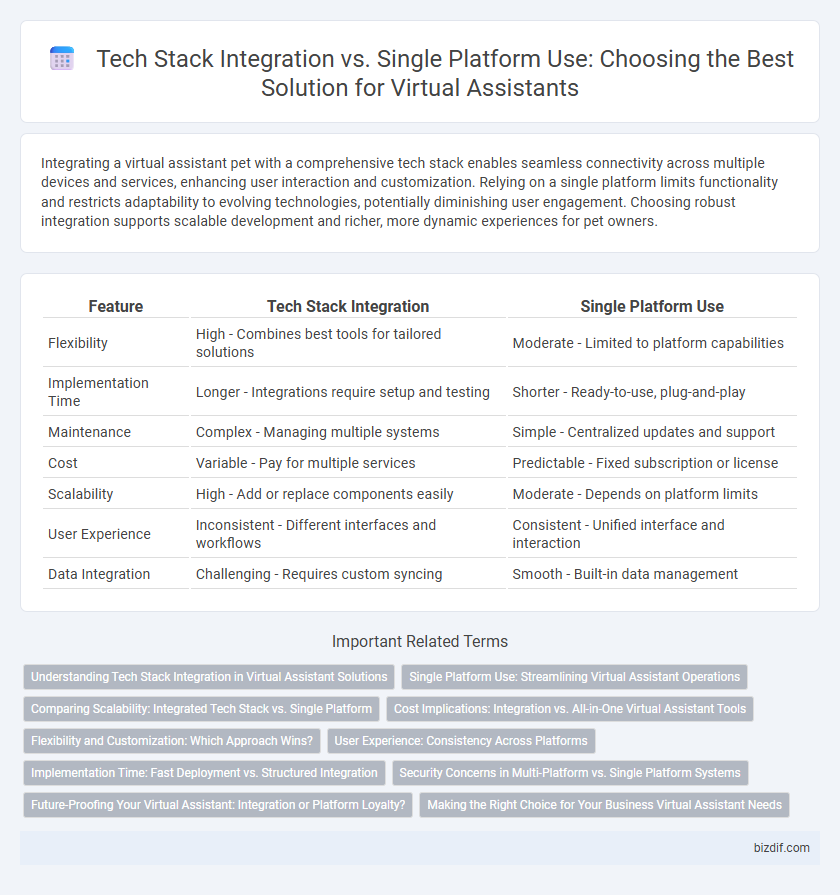Integrating a virtual assistant pet with a comprehensive tech stack enables seamless connectivity across multiple devices and services, enhancing user interaction and customization. Relying on a single platform limits functionality and restricts adaptability to evolving technologies, potentially diminishing user engagement. Choosing robust integration supports scalable development and richer, more dynamic experiences for pet owners.
Table of Comparison
| Feature | Tech Stack Integration | Single Platform Use |
|---|---|---|
| Flexibility | High - Combines best tools for tailored solutions | Moderate - Limited to platform capabilities |
| Implementation Time | Longer - Integrations require setup and testing | Shorter - Ready-to-use, plug-and-play |
| Maintenance | Complex - Managing multiple systems | Simple - Centralized updates and support |
| Cost | Variable - Pay for multiple services | Predictable - Fixed subscription or license |
| Scalability | High - Add or replace components easily | Moderate - Depends on platform limits |
| User Experience | Inconsistent - Different interfaces and workflows | Consistent - Unified interface and interaction |
| Data Integration | Challenging - Requires custom syncing | Smooth - Built-in data management |
Understanding Tech Stack Integration in Virtual Assistant Solutions
Tech stack integration in virtual assistant solutions enables seamless communication between diverse software components such as natural language processing, machine learning models, and backend databases, enhancing functionality and user experience. Unlike single platform use, integrating multiple technologies allows for customization and scalability tailored to specific business needs. Efficient integration leverages APIs and middleware to unify disparate systems, ensuring real-time data flow and consistent performance across the virtual assistant ecosystem.
Single Platform Use: Streamlining Virtual Assistant Operations
Single platform use in virtual assistant operations centralizes functionalities, enhancing efficiency by reducing integration complexities associated with diverse tech stacks. It streamlines workflows, minimizes compatibility issues, and accelerates deployment through unified interfaces and consistent data management. This approach supports scalable customization and real-time updates, ensuring seamless user experiences and operational reliability.
Comparing Scalability: Integrated Tech Stack vs. Single Platform
Integrated tech stacks offer superior scalability by enabling businesses to combine specialized tools tailored to specific tasks, allowing seamless expansions and adaptations as demands grow. Single platforms often face limitations in flexibility and feature breadth, potentially hindering performance when scaling complex operations or integrating new functionalities. Enterprises prioritizing rapid growth and diverse capabilities tend to benefit more from customizable, modular tech stacks that support iterative scalability and innovation.
Cost Implications: Integration vs. All-in-One Virtual Assistant Tools
Integrating multiple virtual assistant technologies often incurs higher costs due to licensing fees, development, and ongoing maintenance required to ensure seamless interoperability. Conversely, all-in-one virtual assistant platforms typically offer a unified solution with lower upfront expenses and simplified management, reducing total cost of ownership. Businesses must evaluate budget constraints alongside scalability needs when deciding between tech stack integration and single-platform adoption.
Flexibility and Customization: Which Approach Wins?
Tech stack integration offers superior flexibility, enabling businesses to tailor virtual assistant capabilities by combining specialized tools like natural language processing APIs, machine learning frameworks, and cloud services for a customized user experience. Single platform use simplifies deployment but often limits customization options, restricting adaptability to unique workflows or evolving business needs. For organizations prioritizing dynamic functionality and scalable solutions, integrated tech stacks outperform single platforms in delivering personalized and future-proof virtual assistant systems.
User Experience: Consistency Across Platforms
Tech stack integration enhances user experience by ensuring consistency across multiple platforms, allowing seamless interactions regardless of the device or operating system. Users benefit from synchronized data and uniform interface elements, reducing friction and learning curves when switching between apps. In contrast, single platform use may limit flexibility, potentially causing fragmented experiences and inconsistency in features or design across varying environments.
Implementation Time: Fast Deployment vs. Structured Integration
Tech stack integration enables faster deployment by allowing virtual assistants to connect with existing tools and APIs without extensive restructuring. Single platform use offers structured integration but often requires longer implementation time due to the need for configuring all functionalities within one ecosystem. Choosing between these approaches depends on balancing quick rollout needs with the desire for a cohesive, unified system.
Security Concerns in Multi-Platform vs. Single Platform Systems
Multi-platform virtual assistant systems increase attack surfaces due to varied tech stack integration, raising risks like inconsistent encryption standards and authentication vulnerabilities. Single platform solutions offer streamlined security management with unified protocols, reducing potential entry points for cyber threats. However, thorough vetting of third-party components remains critical regardless of architecture to ensure robust data protection.
Future-Proofing Your Virtual Assistant: Integration or Platform Loyalty?
Choosing tech stack integration for your virtual assistant allows seamless connectivity with diverse APIs and evolving technologies, ensuring adaptability amid rapid AI advancements. Relying solely on a single platform may limit customization and scalability, risking obsolescence as market demands shift. Prioritizing modular integration strategies enhances future-proofing by enabling continuous feature updates and cross-platform compatibility.
Making the Right Choice for Your Business Virtual Assistant Needs
Choosing between tech stack integration and a single platform for your business virtual assistant depends on scalability, customization, and maintenance requirements. Tech stack integration offers flexibility by combining the best tools and APIs, enabling tailored workflows and advanced functionalities, while a single platform provides streamlined implementation and consistent user experience with less technical overhead. Evaluating your business's growth trajectory, budget constraints, and specific automation goals ensures an optimal virtual assistant setup that maximizes efficiency and ROI.
Tech stack integration vs Single platform use Infographic

 bizdif.com
bizdif.com